STUDENTS PROJECTS
2010
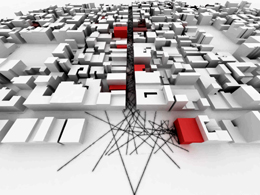
17 February, 2011
Civic University
Integration of the University of Patras with the centre of the city.
Student: Alexandrou Giorgos, Bakagiannis Pavlos, Tsiros Giorgos
Professor: Prof. Aikaterini Liapi
University: Architectural School of the University of Patras
Presentation Date: March 2010
Abstract
In our diploma project we focused on resolving the problematic relation between the city of Patras and the University of Patras. Our goal was to create connections between the university and the city and moreover reinvent the role of the university in the context of a contemporary city.
Text
In our diploma project we focused on resolving the problematic relation between the city of Patras and the University of Patras. During the thirty years that the University of Patras exists there has been little interaction with the city, mostly due to the distance of fifteen kilometers that stand between them. The major problem we identified was that, while Patras is where the majority of the university's students live, it offers no or limited connections to the university itself, connections such as transportation, university spaces in the city or activities, lectures and exhibitions.
Our goal was to create this kind of connections and moreover reinvent the role of the university in the context of a contemporary city. In fact we believe that such a city should have spaces-buildings dedicated to this connection, spaces hosting student-university exhibitions, lectures and open conferences, concerts, movies and plays, produced by students, reading spaces and small libraries, etc.
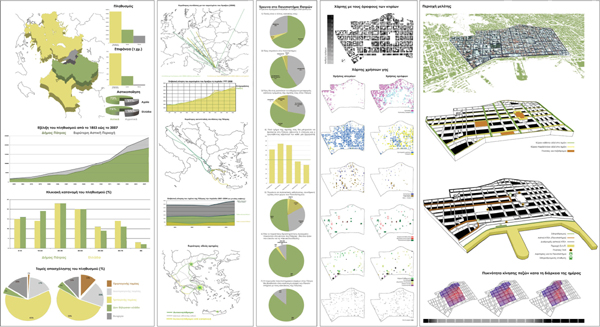
In order to inject the new programs in the city we selected mostly unused or abandoned building in the city centre. We needed to create a network of university spaces that would be integrated with the city's existing networks (transport, public, commercial) and in the same time be easily recognized as something different. A network that its density would allow pedestrians to both grasp (visually) its existence and easily navigate from node to node and in the same time feel welcome to wander and explore its units, in other words, create a unity but not a ghetto. Furthermore the design of the network's units should be uniform and contemporary in the same time bearing university's principals of innovation and knowledge.
Having that in mind we created three zones of programs in the city centre according to their use, student or public. In the red zone we place the reading rooms of the University of Patras with small magazine libraries. In the green zone we place the cultural institutes of the university, and in the yellow zone we install exhibition galleries for university use and a conference centre.
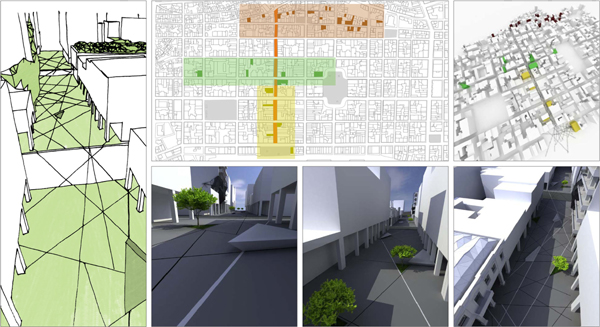
In this case we selected α seven-story building of the 70's, to set an example for the exhibition galleries situated in the yellow zone. Situated on Agiou Nikolaou street, perhaps the most renowned and commercial street in Patras, the assembly hosts mainly offices and on the ground floor some stores. We use one side of the building from the ground to the third flour, in fact we use one store and two apartments on the floors, and we install the new programs, a reception, three floors of exhibition space and vertical movement connecting the parts. Every part of the intervention is shelled in a surface adjusted to the existing spaces and thus creating the new ones. On the outside the surface becomes a distinctive label for the building while on the inside it dissolves into the walls.
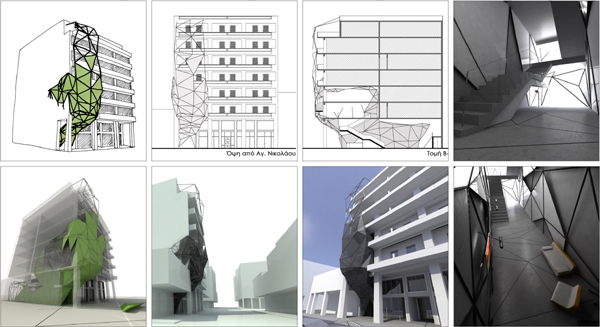
This building that has once been the hotel 'Metropolis' was selected for its location on Trion Summaxon square, focus point for Patras visitors as it is within walking distance from the train and bus stations and the entrance to the city's port. Furthermore the building is a remarkable example of neoclassical architecture built in the 20's, its facade has been recently restored but the interior remain in bad condition.
So it is in this site that we decided to install programs that would promote and advertise university activities to the city. We therefore create an information centre on the base level of the building that is open to the public and designed as an extention of the square, a sheltered public space tha would from time to time host open air exhibitions. In addition to that the upper levels are dedicated to an auditorium-conference centre where lectures and other univercity events could be organised.
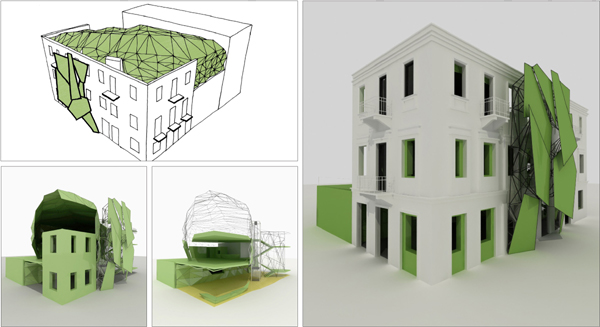
In this design solution we kept the facade intact threw away the interior and rebuilt it from scratch using a surface constructed by triangles as ceiling, wall or window. This triangular pattern is passed on the floor of the ground level and continues to the public square creating an interesting tiling and some urban furniture.
A set of polygons, resembling a broken plane is projected on the front of the building facing the public square, in that way making more evident and distinctive the new public programs hosted inside.
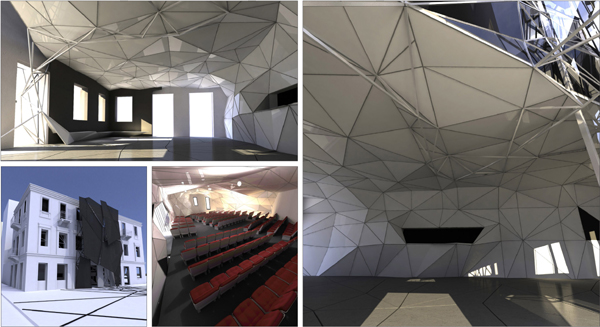
Situated on the corner of Agiou Nikolaou and Korinthou street this set of buildings is the example we set for sites accommodating the university's cultural activities (green zone). In fact the building on the corner, the former hall of Prapopoulos industrial family, and two more across Korinthou street will host activities of the university connected to music. All three buildings are fine specimens of architecture, the ''Prapopoulos Hall'' bears baroque and art nouveau details while the two others offer an insight on neoclassical architecture.
Today in all three buildings the ground floor is used by stores, some of which are closed, and the first floor remains empty and in bad condition while roofs need extended repair due to the long abandoned upper levels.
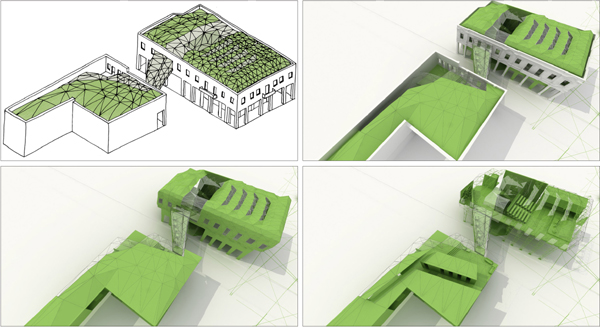
Our intervention, like the site itself is separated (by the street) in two sections, the first and public one hosts a music hall and a lobby with a bar in the ''Prapopoulos's" building first floor and at its base level a small public park, and the entrance (stairs and elevator), and the second and more student oriented, located on the first floor of the two building across the street that hosts practice rooms for music, e recording studio, a lobby, the radio station of the university and an office. Although separated these two section have a meeting point, a bridge connecting them making communication between them possible, offering a powerful view of the city and in the same time advertising the new activities to its residents.
Our basic intention was to use the city's abandoned or unused building and spaces to inject with our programs and in this particular example we use empty stores on the ground floor to create public space, vertical movement and foundation in order to exploit the unused first floors.
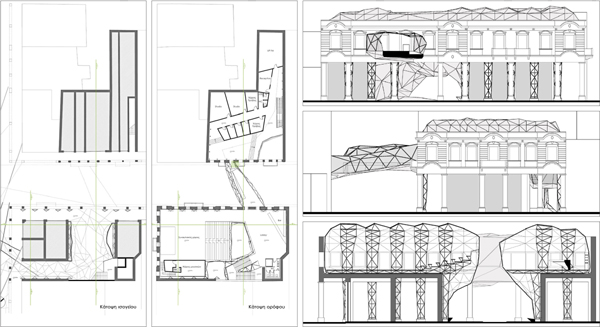
The new programs introduced to the buildings are placed into ''bubbles'' that are completely independent from the rest of the building, ''bubbles'' that consist of a triangulated surface twisting and turning to create walls and roof and of structural elements supporting the skin-surface and the new floor. The same surface is used to create the link between the public and student section of the design, the bridge, and in the process of doing so the dimensions of the triangles and the ''roughness'' of the surface change following the rule : Public= small, rough and intense while Private= large, plane and calm.
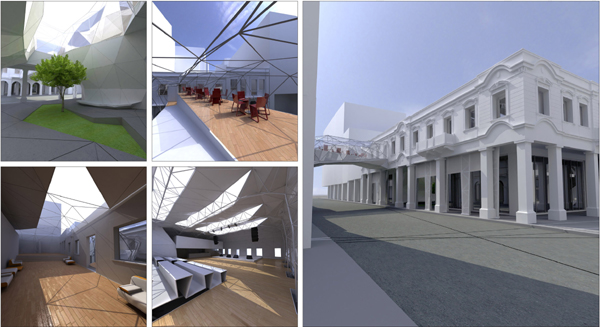
In the case of the university's reading facilities we decided to go with a large number of small buildings centered around Ifaistou pedestrian street that would be open all day and all night, organized and administrated by students. Their location near the pedestrian offers a balance of quiet days and vivid nights, an equilibrium of serenity and security. Each building is referred to a different school and offers a casual place to read, work, meet and exchange thoughts. Due to their use these facilities do not need promotion or publicity so we decide to intervene simply by restoring the outer shell and adding a small mark-sign and in the interior we retain the structural integrity of the building rearranging space when needed.
The building we selected as an example is an abandoned storehouse on the corner of Pantanassis street and Ifaistou pedestrian street. We restore the building's facade and roof and remove the interior walls thus creating a single space where a library, a small living room, a kitchenette, a bathroom and a computer corner are installed.
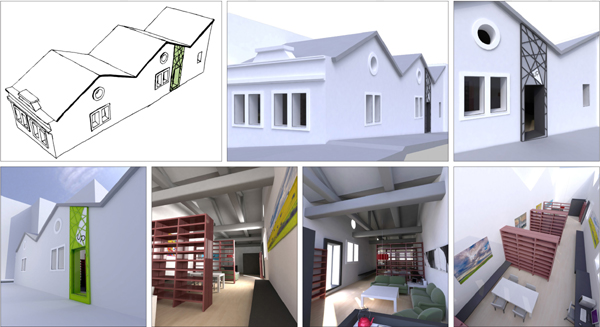
We created a network of university spaces integrated with the city's existing networks (transport, public, commercial) and in the same time easily recognized as something different and new. A network that its density would allow pedestrians to both grasp (visually) its existence-and easily navigate from node to node while in the same time feel welcome to wander and explore its units, in other words, create a unity but not a ghetto. The design of the network's units should be uniform and contemporary in the same time bearing university's principals of innovation and knowledge. Having that in mind we created three zones of programs in the city centre according to their use, student, public or both.
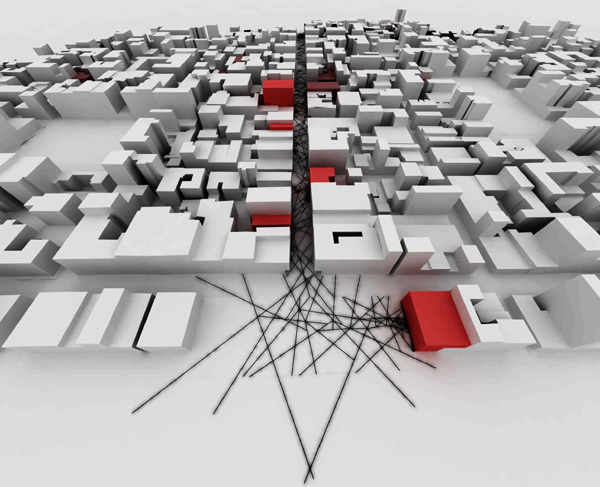
Model Construction Civic University
Walkthrough Civic University










